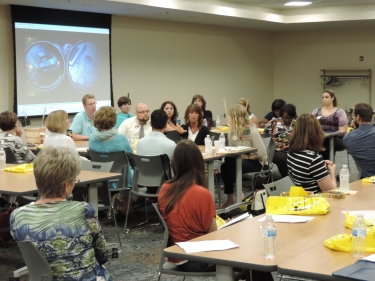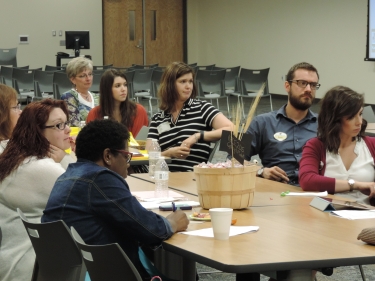
by Kelly Rogge, KCKCC
Kansas City Kansas Community College was host to members of the Kansas Association of Colleges and Employers in July as part of the organization’s annual summer workshop.
KACE’s Drive-In Workshop was July 22 at the Thomas R. Burke Technical Education Center. The nonprofit organization works to provide a link between Kansas employers and career services personnel at Kansas and northwest Missouri colleges and universities. Members have the opportunity to share experiences, information and ideas while promoting high professional standards and career advancement. Almost 40 individuals attended the annual workshop.
“No matter if you are representing an employer or an educational institution, you are all here for students,” said Michael Vitale, vice president for academic affairs. “If you are on the education side, you want to be sure that when you are producing graduates, they have the skills to enter the business world and get jobs. And if you are on the employer side, you want to make sure we are giving you employable graduates.”
Inspired by farmers’ markets, the theme for this year’s workshop was “KACE Going to Market.” Fresh fruits and vegetables as well as a variety of healthy snacks were available throughout the day to go along with the theme.
Discussions included the challenges and successes involved with connecting international students with employers in the region and managing an intergenerational workforce. There was also a panel discussion featuring Nakita Elwod, Amanda Ramirez, and Kayla White, who are all current students or recent graduates. They all shared their experiences and what it meant to be acknowledged by instructors as “traditional students” as opposed to “non-traditional students.”
“Sometimes as educators we think we know what students want, but until we actually engage the students and listen to them about their experiences, we often miss the mark,” said Marisa Gray, director for workforce and career development at KCKCC. “The experiences shared by the panel members provided insight that will be helpful in how we can approach and provide resources to aid in their success.”
To close the workshop, attendees had the opportunity to engage in activities on managing an intergenerational workforce, from millennials to baby boomers, led by Erin Blocher, director of the Bloch Communication Center at the University of Missouri-Kansas City. Conference participants then were able to take a tour of KCKCC-TEC, which opened two years ago in a former Wal-Mart and learned about the different programs and services offered at the facility.
“It was really quite a sight to behold,” Vitale said of the transformation that occurred to create what is now KCKCC-TEC. “I came to Kansas City in summer 2013, and when I saw this place, I was amazed. They were still building walls and there was no flooring but it was so transformed already.”
Kelly Rogge is the public information supervisor at KCKCC.


